This article was originally published in the February 1997 issue of Sport Rider.
Generally, if the weather is cool and dry or the tar strips are small, few in number or old, a motorcyclist can ride over them without a problem. It’s when the sealer is new, wet or hot that traction is affected. A wide, thick strip of tar on a hot day can quickly reduce your available traction, the front tire’s in particular.
The rider in the first photo is coming into a section of road with a myriad of tar strips on the surface. At this point he picks a line that takes him over the fewest number of strips.
- In many parts of the country, tar sealer is used to repair damaged and cracked pavement. This method of highway maintenance may work fine for the majority of vehicles traveling America's highways, but a maze of oily, black-tar strips can be trouble for the unsuspecting motorcyclist.
- Anytime you encounter a large amount of the slippery black goo, the smartest move is to reduce your speed by slowly rolling off the gas and braking gently. (Don't simply chop the throttle and brake aggressively or you could end up on your head.) Slowing down a bit will allow you to check out the amount of traction available; you can then look through the turn in order to determine which is the best line through the mess. Yes, your line and cornering speed are now dictated by the tar strips, though giving in and following the cleanest asphalt possible is clearly better than getting caught in the slick stuff. The rider pictured has slowed his speed and has chosen an inside line that's largely devoid of tar strips.
- It's important to pick a line that places your tires on the tar for the least amount of time possible. If you have a choice between riding over a strip that runs parallel or perpendicular to your direction of travel, always pick the latter. Trouble is most often encountered when traveling over a large, wide patch. Stay smooth on the controls, making small inputs to the throttle or brakes.
- It's important to remember that in a corner littered with debris, and especially tar sealer, it's best to alter your line accordingly. And if you are to do that, it's wise to reduce your speed to allow yourself more time and, hence, space to make decisions.
If your bike does start to lose traction and slide, don’t tense up because traction will be good beyond the strip. Stay relaxed at the controls and keep the throttle steady. Chopping the throttle will load the front suspension, transferring more weight to the front and possibly overtaxing the front tire. At the corner exit, apply the throttle slowly and smoothly, as the lack of traction caused by the sealer will no doubt inhibit your bike’s ability to accelerate hard out of the corner.
For another Riding Skill Series take a look at how riding in the rain can still be enjoyable.
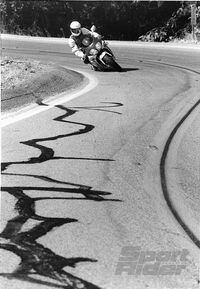
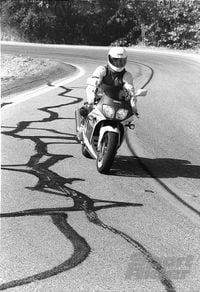
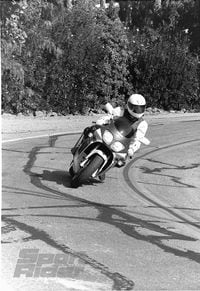
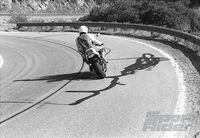
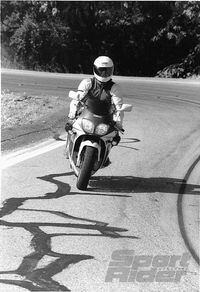
/cloudfront-us-east-1.images.arcpublishing.com/octane/7EUSM4GQEBEFTPAYZ6MOMKMMUQ.jpg)
/cloudfront-us-east-1.images.arcpublishing.com/octane/ZN44KZLHD5CHVIY3WZYAGTPGSI.jpg)
/cloudfront-us-east-1.images.arcpublishing.com/octane/5A776WXBY5GAPDYFTTUEUZNIJA.jpg)
/cloudfront-us-east-1.images.arcpublishing.com/octane/NCYHFQ2S3BAT7EC7VDN2ONGRTU.jpg)
/cloudfront-us-east-1.images.arcpublishing.com/octane/XQORS527YFFT3MVI326EOEYJUI.jpg)
/cloudfront-us-east-1.images.arcpublishing.com/octane/TVDPP3TGMZHODFXASIFUM2KD34.jpg)
/cloudfront-us-east-1.images.arcpublishing.com/octane/EWDMR3DDTBBQPI7DQVZCLMRFAE.jpg)
/cloudfront-us-east-1.images.arcpublishing.com/octane/4XHHLVOUKFE3PDSWNSV4JJMGOE.jpg)
/cloudfront-us-east-1.images.arcpublishing.com/octane/5RLI3NQKQJA3LKKCQHRXQFTL6Q.jpg)
/cloudfront-us-east-1.images.arcpublishing.com/octane/3QCYJCI2RNBENIRWAKEOEKHFUM.jpg)
/cloudfront-us-east-1.images.arcpublishing.com/octane/XJFFFMRN6VEZ7CDNAGKWVPC3H4.jpg)
/cloudfront-us-east-1.images.arcpublishing.com/octane/RMC3CHWSHFAUJA2WJ2FVG4NBOA.jpg)
/cloudfront-us-east-1.images.arcpublishing.com/octane/WXEZV4WAYBERFKSRE5M7GQBW7A.jpg)
/cloudfront-us-east-1.images.arcpublishing.com/octane/LO3PZVGICFGJZBNUA2ORUSAUSE.jpg)
/cloudfront-us-east-1.images.arcpublishing.com/octane/UFHLTNOXLVARVLZV32M6ZJZV4Y.jpg)
/cloudfront-us-east-1.images.arcpublishing.com/octane/CTSWNU7SNNCC3LWB2KATYZ5AXY.jpg)
/cloudfront-us-east-1.images.arcpublishing.com/octane/72EPJVNA2VGVXJ2BVDFFLN67KQ.jpg)
/cloudfront-us-east-1.images.arcpublishing.com/octane/A7C4GNXEHNHC3LL6RETG6MIPPY.jpg)
/cloudfront-us-east-1.images.arcpublishing.com/octane/Q4KZ7ACKF5BVTE56LMG7RPJCEM.jpg)
/cloudfront-us-east-1.images.arcpublishing.com/octane/RQ2CXG6ATJBUZGUR7NP35C3VBE.jpg)
/cloudfront-us-east-1.images.arcpublishing.com/octane/MWSEWNFALBBJHOQGZTUUPVOQOU.jpg)
/cloudfront-us-east-1.images.arcpublishing.com/octane/LTPXG4ZHCVFNDNILFQ6PN6YUKI.jpg)
/cloudfront-us-east-1.images.arcpublishing.com/octane/EAEWHFARGVGHFH4N4BDOSNBJSU.jpg)
/cloudfront-us-east-1.images.arcpublishing.com/octane/AZ7H35TQSZDKZCVM4S6CHERQEU.jpg)